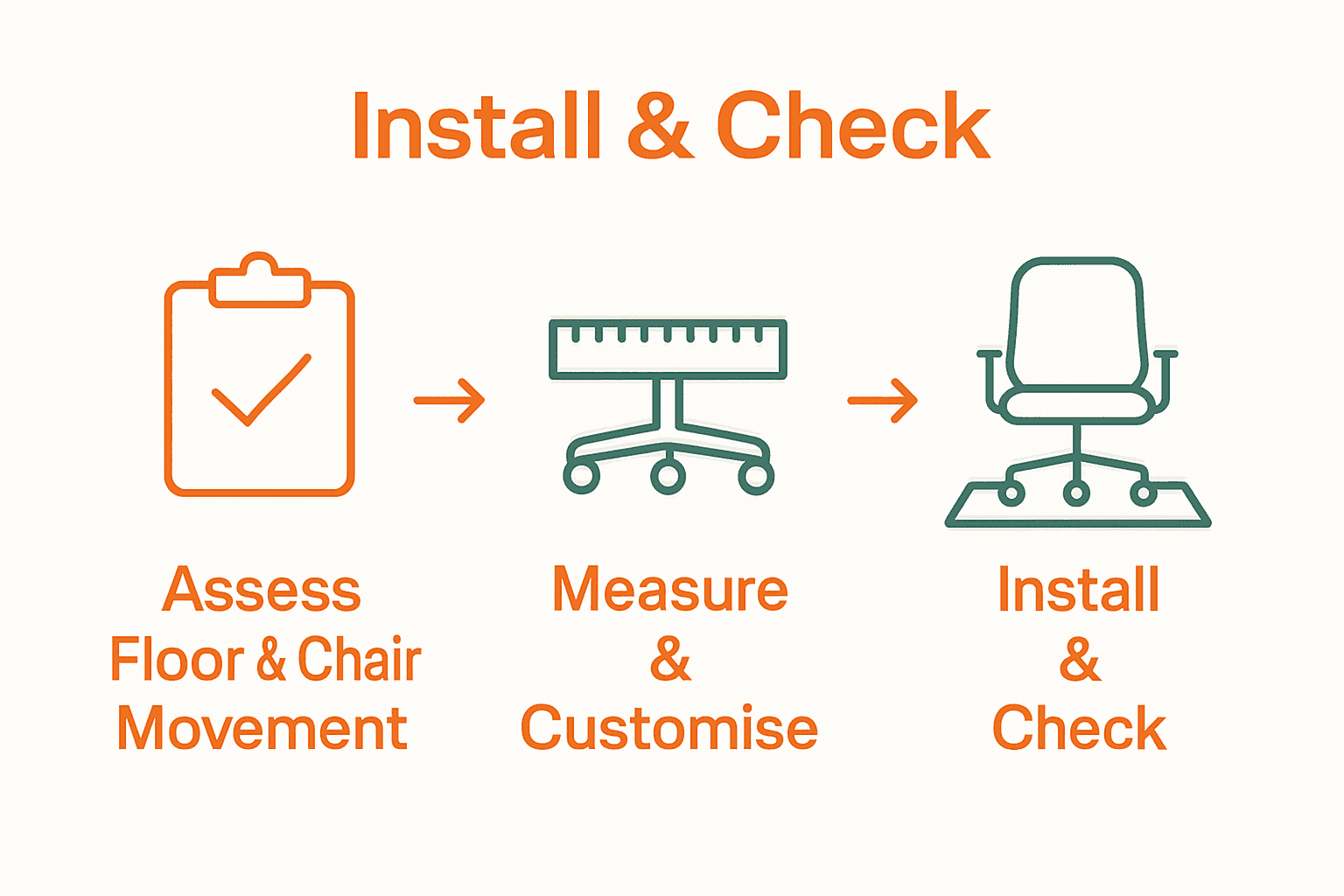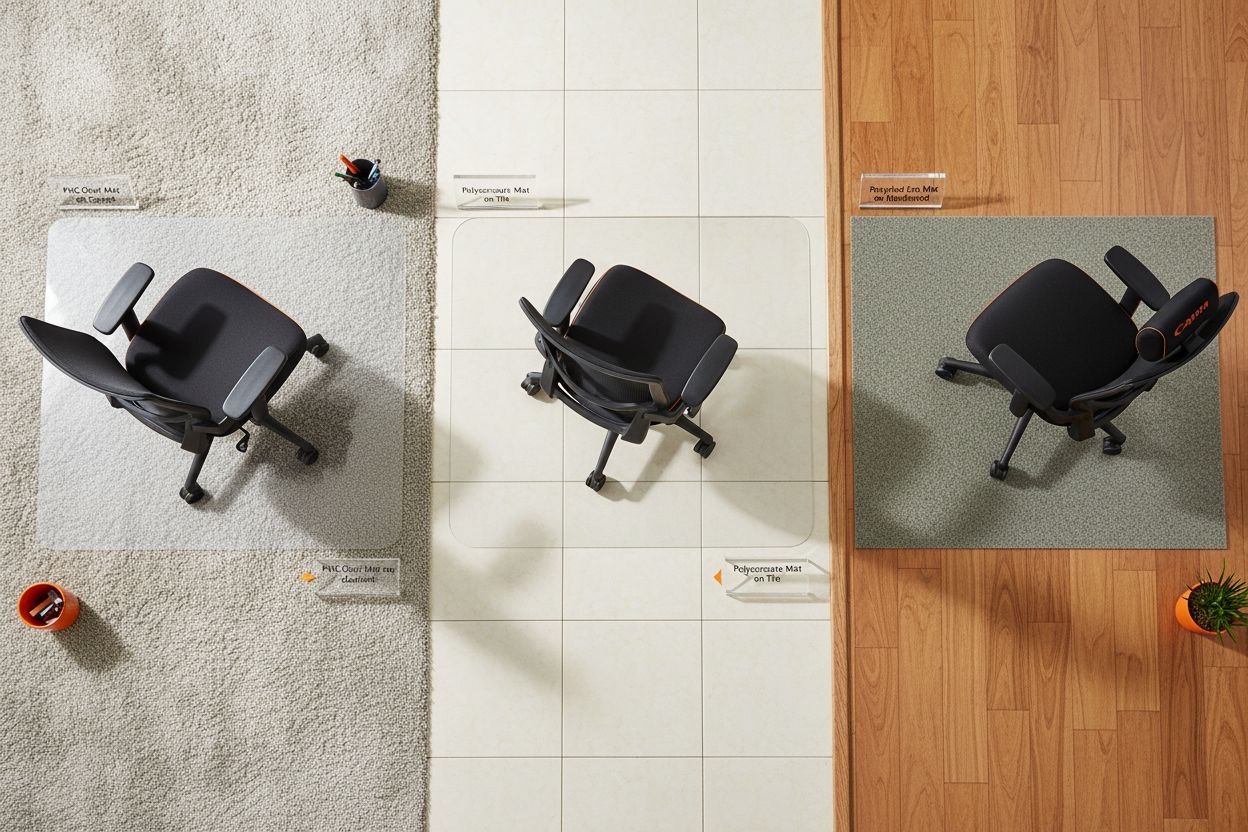Did you know that office chairs can cause over 80 percent of visible floor damage in busy workspaces? Protecting your flooring not only saves money on repairs but also keeps your office looking clean and professional. Knowing which chair mat best fits your space depends on the type of floor, how your chair moves each day, and a few practical choices you might not expect.
Quick Summary
| Key Point | Explanation |
|---|---|
| 1. Understand your floor and chair type | Assess whether your floor is hardwood, carpet, or tile to select the right mat type for protection. |
| 2. Measure your workspace accurately | Use precise measurements of your desk and chair movement area to ensure the mat fits perfectly without gaps. |
| 3. Choose a mat based on use and sustainability | Select between PVC, polycarbonate, or eco mats depending on your office needs and environmental preferences. |
| 4. Install the mat correctly for stability | Ensure the mat lies flat and extends beyond your chair’s movement area to protect your floor and promote smooth usage. |
| 5. Periodically check mat performance | Regularly inspect the mat and floor beneath for wear or damage, maintaining a protective environment for your workspace. |
 |
|
Table of Contents
- Step 1: Assess Floor Type And Chair Movement
- Step 2: Select An Appropriate Mat Solution
- Step 3: Measure Space And Customise Mat Size
- Step 4: Install Mat In The Correct Position
- Step 5: Verify Mat Stability And Floor Protection
Step 1: Assess Floor Type and Chair Movement
Before selecting a protective mat, you need to understand your specific floor surface and chair movement patterns. According to TrustedMats UK, different floor types require different mat solutions.
Start by examining your floor material carefully. Are you working on hardwood, laminate, tile, stone, or carpet with underlay? Each surface demands a unique approach. For carpeted areas, the depth of your carpet pile matters significantly. A simple paperclip test can help determine the pile depth - just press a paperclip into the carpet and measure how deeply it sinks.
For hard floors like wood or tile, you will want a smooth backed mat that provides stability without scratching the surface. According to Paperstone UK, polycarbonate mats offer excellent durability and resist cracking or yellowing.
Pro Tip: Always measure your workspace before purchasing a mat. The mat should cover the entire area where your chair typically moves.
Consider your chair’s movement patterns too. Do you frequently roll between desk and filing cabinet? Or stay mostly in one spot? Understanding your typical movement will help you choose a mat with the right thickness and grip.
For carpet environments, look for mats with coarse underside grippers that prevent unwanted sliding. On hard floors, a smooth backing ensures your mat stays put without damaging the surface.
Ready to protect your floor and make your workspace more comfortable? The next step involves selecting the perfect mat for your specific environment.
Step 2: Select an Appropriate Mat Solution
Now that you understand your floor type and chair movement, it is time to choose the perfect mat solution that balances protection, functionality, and environmental considerations. According to Paperstone UK, you have multiple material options that offer different benefits.
PVC mats provide maximum transparency and durability for normal office use. They are straightforward, reliable, and will withstand daily rolling and movement. However, if you are environmentally conscious, polycarbonate mats present an excellent alternative. These mats are odourless, free from toxic chemicals, and remarkably easy to clean.
For those prioritizing sustainability, TrustedMats UK offers eco chair mats made with 50% recycled material and are 100% recyclable. These innovative mats come in smooth back options for hard floors and claw back designs for carpeted surfaces.

Pro Tip: Consider your long term usage. A slightly more expensive mat that lasts longer can be more cost effective than a cheaper alternative that needs frequent replacement.
When selecting your mat, pay attention to thickness and edge design. Thinner mats work well on hard surfaces, while thicker mats provide better cushioning on carpets. Look for bevelled edges that prevent tripping and ensure smooth chair movement.
Think about your specific workspace aesthetic too. Clear mats blend seamlessly with most office decors, while coloured or branded options can add a professional touch to your environment.
Ready to make your final selection? The next step involves proper mat placement to maximise floor protection and chair mobility.
Here’s a comparison of common chair mat materials and their key features:
| Mat Material | Best For | Notable Benefits | Environmental Impact |
|---|---|---|---|
| PVC | Standard office use | Transparent Durable Affordable |
Not typically recyclable |
| Polycarbonate | Heavy use Hard floors |
Odourless Fire resistant Easy to clean |
100% recyclable |
| Eco (Recycled) | Sustainability focused | Made from 50% recycled material Variety of backings |
Fully recyclable |
Step 3: Measure Space and Customise Mat Size
With your ideal mat material selected, precision becomes key. According to TrustedMats, accurate measurements are crucial for finding the perfect chair mat that protects your floor and supports smooth movement.
Begin by measuring your total floor space carefully. You will want to capture the width of your workstation, the dimensions of your chair base, and critically the roll area where your chair actually moves. This means looking beyond just the space under your desk and considering the full range of motion you typically use.
If you are working with carpeted floors, an extra step is required. TrustedMats recommends performing a simple paperclip test to determine your carpet pile and underlay depth. Press a paperclip into your carpet and measure how deeply it sinks this will help you select a mat with the right backing depth.
Pro Tip: Always measure twice and order once. A few extra minutes with a measuring tape can save you from purchasing an ill fitting mat.
When measuring, use a metal tape measure for accuracy and consider these key dimensions carpet depth mat width chair base movement area. Some manufacturers offer custom sizing options which can be perfect for unique workspace configurations.
Remember that your mat should extend at least several centimetres beyond your chair’s typical movement zone. This ensures comprehensive floor protection and smooth rolling capability.
Ready to transform your workspace? The next step involves preparing your floor for mat installation.
Step 4: Install Mat in the Correct Position
Now comes the critical moment of positioning your chair mat for maximum protection and functionality. According to Paperstone UK, proper placement is essential to protect your floor and facilitate smooth chair movement while reducing leg fatigue.
Start by ensuring your floor is completely clean and dry. Any dust or debris can prevent proper mat adhesion and potentially scratch your floor surface. Gently place the mat in your primary workspace area, focusing on creating a smooth surface that covers your chair’s entire movement range.
According to Office Stationery UK, consider using a lipped or contoured mat that allows you to slide closer to your desk. These specialized mats feature an edge that can tuck partially under your desk, providing a more ergonomic workspace while maintaining floor protection.
Pro Tip: For hard floors, look for mats with anti slip edges to ensure maximum stability and prevent unwanted sliding.
If you are working on carpet, ensure the mat’s backing matches your carpet depth. The mat should lie flat without wrinkling or creating uneven surfaces that could cause tripping hazards. For hard floors, a smooth backing will help the mat stay in place without damaging the underlying surface.
Position the mat so that it extends slightly beyond your chair’s typical rolling area. This extra coverage provides comprehensive floor protection and ensures smooth movement across your workspace.
Ready to enjoy your newly protected floor? The final step involves maintaining your mat and floor for long term performance.
Step 5: Verify Mat Stability and Floor Protection
With your mat installed, it is time to ensure long term performance and floor protection. According to Office Stationery UK, selecting a high quality mat like polycarbonate provides exceptional durability and protection.
Begin by testing the mat’s stability. Roll your chair across the entire surface and observe how smoothly it moves. The mat should provide consistent support without bunching wrinkling or creating uneven surfaces. Check that the edges remain firmly in place and there are no unexpected slips or shifts.
According to TrustedMats, some PVC chair mats come with impressive guarantees like 20 year warranties. This means you can be confident in your floor protection. Look for mats that are recyclable and designed to withstand normal office use without cracking or degrading.
Pro Tip: Periodically lift the mat and inspect the floor underneath to ensure no scratching or damage is occurring.
Polycarbonate mats offer additional benefits beyond floor protection. These mats are fire resistant odourless and can even reduce electrostatic build up making them ideal for modern workspaces. They work exceptionally well on heated floors and provide a stable surface for continuous movement.
Check that your mat provides complete coverage of your typical chair movement area. Any exposed floor could still be at risk of damage. A well positioned mat acts as a protective shield preventing wear and tear from constant rolling and movement.
Ready to enjoy your perfectly protected workspace? You have successfully transformed your office environment with a professional floor protection solution.
Discover Office Chair Mats That Actually Protect and Last
If you are tired of scratched floors, worn carpets, or slippery surfaces under your office chair, you are not alone. Many readers, just like you, are frustrated by the lack of mats that truly solve these problems. The article highlighted the challenges of finding the right mat to match your unique floor type, your typical rolling patterns, and the need for reliable durability. You want security, seamless movement, and a custom fit that brings peace of mind to your workspace.
Find your custom office mat solution today

Act now and experience the difference with Mats4U’s expert floor protection options. Shop a wide choice of made-to-measure office chair mats that are designed for every floor type and movement need. For both standard and specialist environments, choose a mat that fits perfectly and performs beyond expectations. Ready to transform your office with lasting protection? Visit Mats4U to protect your floor and upgrade your office comfort today.
Frequently Asked Questions
How do I determine the right mat for my floor type?
To choose the right mat, first identify your floor surface—whether it’s hardwood, carpet, or tile. Measure areas where your chair moves and consider using a paperclip to check carpet pile depth if applicable.
What thickness should my chair mat have for carpeted floors?
For carpeted floors, opt for thicker mats to provide adequate cushioning and support. Aim for mats specifically designed for deeper carpet piles to prevent sinking and maintain stability.
How do I measure my workspace for a chair mat?
To measure your workspace, capture the width of your workstation and the dimensions of your chair base, focusing on the area where your chair rolls. Ensure that your mat extends several centimeters beyond this movement zone for full floor protection.
What is the best way to install my chair mat?
Clean and dry your floor thoroughly before placing the mat in your primary workspace area. Ensure that the mat lies flat without wrinkles, and position it so that it covers the entire range of motion of your chair.
How can I maintain my chair mat and floor for long-term use?
To maintain your mat, regularly lift it to check for any scratches or damage on the floor underneath. Clean the mat as needed, and ensure it remains stable and free from uneven surfaces to prolong its lifespan.
What should I do if my chair mat slips on a hard floor?
If your chair mat slips, consider using mats with anti-slip edges or those designed specifically for hard surfaces. Ensure the area beneath the mat is clean and free of debris, which can help with stability.
Recommended
- 7 Best Carpet Protectors for Office Chairs in 2025 – Mats4U
- How to Keep Chair Mat from Sliding on Hardwood Floors – Mats4U
- The Ultimate Guide to Office Mats for Hard Floors: Protect Your Invest – Mats4U
- Master Commercial Mat Cleaning for Pristine Results – Mats4U
- Non-Toxic Baby Play Mat Safety Checklist Verified | Floorbloom Play Mats









